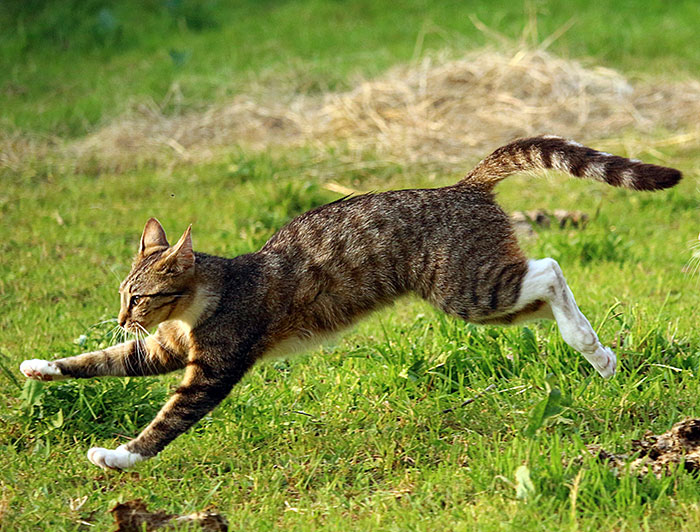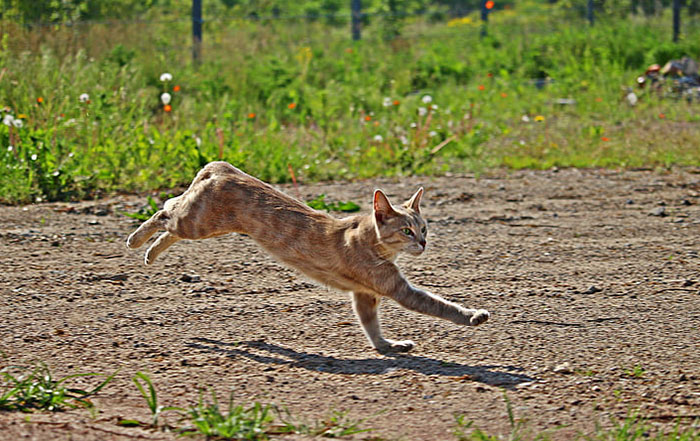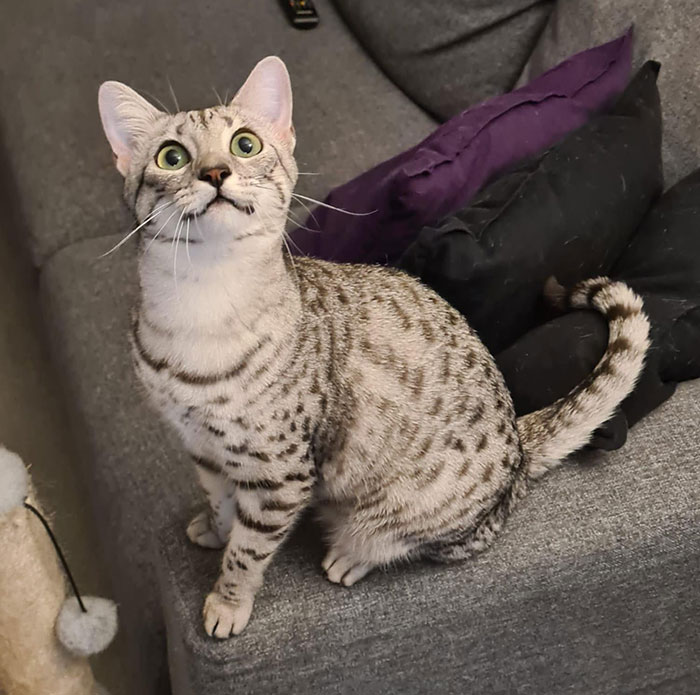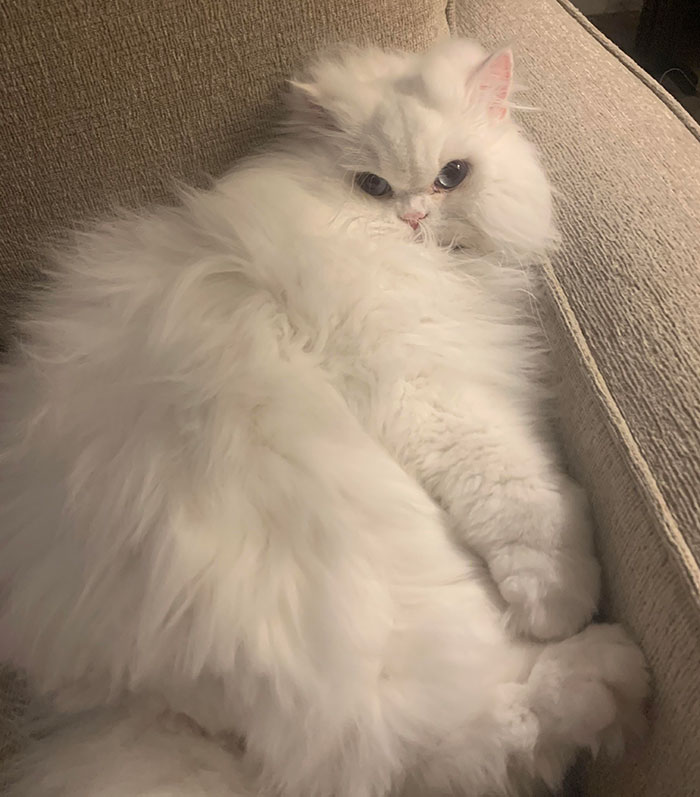Every once in a while, our cats decide to surprise us with their zoomies. Their lightning-quick dashes and cat jumps can often leave us confused.
Have you ever wondered how fast your cat runs or how it manages to run so fast?
Let’s learn about the fantastic cat speed and all you need to know about it.
The information provided herein is for informational purposes only. Please refer to our disclaimer for more details..
Need for Speed: History of the cat’s agility
It’s no secret that cats are built for speed. Most domestic cats are descendants of the African wildcat, a renowned hunter. Their ancestors relied on their speed, nimbleness, and reflexes to hunt and evade predators. While house cats have been domesticated, they still retain the agility of their ancestors.
- House cats can reach speeds around 30 mph.
- Cat's agility comes from a flexible spine and muscular legs.
- Egyptian Mau is one of the fastest domestic cat breeds.
- Older cats are typically slower due to decreased muscle strength.
- In short bursts, cats can outrun trained human sprinters.
Since the fastest land animal is the cheetah – a cat- it should be no surprise that their domesticated cousins run fast as well.
Image credit: pxhere.com
How fast can a cat run?
A cat’s running speed depends on different factors, including its age, size, breed, and health. A domestic house cat can reach speeds of around 30 miles per hour. This is faster than Usain Bolt, who had a top speed of 27.33 miles per hour. However, some larger or more athletic cats, like the Egyptian Mau, may run faster than other breeds.
On the other hand, the fastest wild cats can hit speeds of up to 70 miles per hour in short bursts of 20 to 30 seconds.
Whether wild or domesticated, the fact is that cats are great sprinters who can outrun even the fastest human sprinters.
While cats can run at impressive speeds, they usually run high speeds at short bursts and will not maintain this sprint for a long time. They run about 50-100 yards per bout.
What is the average speed for a house cat?
The average speed of a house cat is 20 to 30 mph. This speed can vary based on factors such as the cat’s breed, age, health, and individual fitness level. Some cats might reach the higher end of this speed range if they are more active or belong to athletic breeds.
Image credit: pickpik.com
This means that the average housecat would impressively beat well-trained athletes at a 100-meter dash.
How are cats able to run so fast?
The cat’s remarkable speed is a product of a flexible spine and muscular legs that allow them to accelerate quickly and maintain high speeds over short distances. Here are a few physiological and anatomical features that aid the speedy cat.
Flexible spine
Cats have a flexible spine that contributes positively to their speed. The elasticity of this spine lengthens the cat’s strides as it runs and makes the body stretch to its entire length. This flexible spine also makes for a powerful back that allows them to change their position mid-air without any damage.
Powerful front and back limbs
The cat’s muscular legs are one of its most critical running instruments. Cats have powerful and elastic muscles, particularly in their hind legs. These muscles give them explosive strength that propels their bodies in a forward motion. In addition, these back legs also help the cat move in a spring-like fashion, allowing for rapid acceleration.
Aerodynamic body
Cats generally have streamlined bodies that help them overcome air resistance. This makes them faster because they can move through the air efficiently as they run.
Paw design
Cats can build traction and run around at incredible speeds with their retractable claws and cushioned foot pads. Their ability to retract and extend their claws also makes cats great climbers.
According to Catster, cats have a dominant paw side, like humans have a dominant hand.
Factors affecting feline speed
Various factors, including breed, age, and physical condition can influence the agility and speed of a cat. Additionally, external factors like air resistance, extreme weather conditions, and terrain can affect how fast a cat can run.
Breed: Different breeds have different levels of agility and speed. Breeds like the Abyssinian and Egyptian Mau are known for their speed and athleticism, while breeds like the Persian or British Shorthair are generally slower due to their relaxed temperament.
Age: Younger cats are usually more agile and faster than older cats. According to PetKeen, cats are at their physical peak between 2 to 4 years. Hence, these cats would run at their top speed at this age.
Physical condition: A cat’s physical health, including muscle strength, joint flexibility, and overall fitness, will influence its speed.
Motivation: When motivated by play, prey, or competition, a cat may have bursts of speed. However, their speed might be slower if they’re just not interested.
Fastest cat breeds
Image credit: Background-Wing3148 (Egyptian Mau)
Some cat breeds are known for their lightning-fast running speeds, making them impressive sprinters among domestic cats.
Here is a list of some of the fastest domestic cat breeds:
- Egyptian Mau
- Abyssinian
- Somali
- Savannah
- Bengal
- Occicat
- Oriental Shorthair
- Balinese
- Sphynx
- Manx
Slowest cat breeds
Image credit: littlerimsss (Persian)
On the other hand, some breeds have slower running speeds. This is usually due to their calm and less active nature.
Here is a list of some of the slowest cat breeds:
- Persian
- British Shorthair
- Exotic Shorthair
- Scottish Fold
- Ragdoll
In addition to this, brachycephalic cats are known to have flat faces that often cause breathing difficulties. According to VCA Hospitals, such cats have increased airway resistance due to their small trachea. Therefore, they may run slower than other breeds.
Frequently asked questions
Which is faster, cat or dog?
On average, dogs are faster than cats. The fastest dog, the Greyhound, can run up to 45 mph. On the other hand, the fastest domestic cat, the Egyptian Mau, runs up to 30 mph. However, this comparison is only based on domestic cats and dogs.
Note that while dogs have their strengths, the average house cat would outpace them in short bursts of speed.
Also, the speed of either a cat or a dog depends on various factors. Therefore, there is no one-size-fits-all answer to this question.
Can a human outrun a cat?
No, a human cannot outrun a healthy cat. On average, a well-trained human sprinter can reach speeds of around 27 miles per hour, approaching the running speed of a house cat.
In short bursts, a cat’s acceleration would definitely surpass that of even the fastest human runners, making it challenging to outrun them.
How fast can old cats run?
As cats age, their running speed decreases due to various factors such as reduced muscle strength and agility. While older cats may not run as fast as their younger counterparts, they can still display impressive bursts of speed.
313views
Share on Facebook
 Dark Mode
Dark Mode 

 No fees, cancel anytime
No fees, cancel anytime 






















































13
0